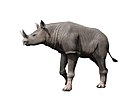
Ancylopoda is a group of browsing, herbivorous, mammals in the Perissodactyla that show long, curved and cleft claws. Morphological evidence indicates the Ancylopoda diverged from the tapirs, rhinoceroses and horses (Euperissodactyla) after the Brontotheria; however, earlier authorities such as Osborn sometimes considered the Ancylopoda to be outside Perissodactyla or, as was popular more recently, to be related to Brontotheriidae.

Moropus is an extinct genus of large perissodactyl mammal in the chalicothere family. They were endemic to North America during the Miocene from ~20.4–13.6 Mya, existing for approximately 6.8 million years. Moropus belonged to the schizotheriine subfamily of chalicotheres, and has the best fossil record of any member of this group; numbers of individuals, including complete skeletons, have been found.

Pachycephalosaurus is a genus of pachycephalosaurid ornithischian dinosaur. The type species, P. wyomingensis, is the only known species, but some researchers argue that Stygimoloch might be a second species, P. spinifer, or a juvenile specimen of P. wyomingensis. It lived during the Maastrichtian age of the Late Cretaceous period in what is now western North America. Remains have been excavated in Montana, South Dakota, Wyoming, and Alberta. The species is known mainly from a single skull, plus a few extremely thick skull roofs. More complete fossils would come to be found in the following years.

Stegoceras is a genus of pachycephalosaurid (dome-headed) dinosaur that lived in what is now North America during the Late Cretaceous period, about 77.5 to 74 million years ago (mya). The first specimens from Alberta, Canada, were described in 1902, and the type species Stegoceras validum was based on these remains. The generic name means "horn roof", and the specific name means "strong". Several other species have been placed in the genus over the years, but these have since been moved to other genera or deemed junior synonyms. Currently only S. validum and S. novomexicanum, named in 2011 from fossils found in New Mexico, remain. The validity of the latter species has also been debated, and it may not even belong to the genus Stegoceras.
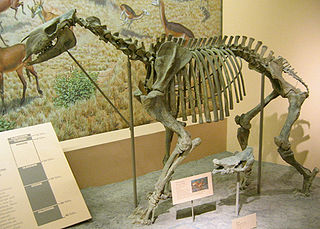
Chalicotheriidae is an extinct family of herbivorous, odd-toed ungulate (perissodactyl) mammals that lived in North America, Eurasia, and Africa from the Middle Eocene to the Early Pleistocene. They are often called chalicotheres, a term which is also applied to the broader grouping of Chalicotherioidea. They are noted for their unusual morphology compared to other ungulates, such as their clawed forelimbs. Members of the subfamily Chalicotheriinae developed elongate gorilla-like forelimbs that are thought to have been used to grasp vegetation. They are thought to have been browsers on foliage as well as possibly bark and fruit.
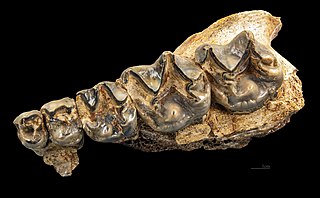
Chalicotherium is a genus of extinct odd-toed ungulates of the order Perissodactyla and family Chalicotheriidae. The genus is known from Europe and Asia, from the Middle Miocene to Late Miocene.

Ancylotherium is an extinct genus of the family Chalicotheriidae, subfamily Schizotheriinae, endemic to Europe, Asia, and Africa during the Late Miocene-Early Pleistocene, existing for approximately 9.8 million years.

Daeodon is an extinct genus of entelodont even-toed ungulates that inhabited North America about 29 to 15.97 million years ago during the latest Oligocene and earliest Miocene. The type species is Daeodon shoshonensis, described by a very questionable holotype by Cope. Some authors synonymize it with Dinohyus hollandi and several other species, but due to the lack of diagnostic material, this is questionable at best.

The John Day Formation is a series of rock strata exposed in the Picture Gorge district of the John Day River basin and elsewhere in north-central Oregon in the United States. The Picture Gorge exposure lies east of the Blue Mountain uplift, which cuts southwest–northeast through the Horse Heaven mining district northeast of Madras. Aside from the Picture Gorge district, which defines the type, the formation is visible on the surface in two other areas: another exposure is in the Warm Springs district west of the uplift, between it and the Cascade Range, and the third is along the south side of the Ochoco Mountains. All three exposures, consisting mainly of tuffaceous sediments and pyroclastic rock rich in silica, lie unconformably between the older rocks of the Clarno Formation below and Columbia River basalts above.

Borissiakia is an extinct genus of chalicothere, a group of herbivorous, odd-toed ungulate (perissodactyl) mammals, that lived during the late Oligocene in Kazakhstan. They had claws that were likely used in a hook-like manner to pull down branches, suggesting they lived as bipedal browsers.

Nestoritherium is an extinct genus of chalicothere; it has been dated to have lived from the late Miocene to the Early Pleistocene. This range makes Nestoritherium one of the most recently dated chalicotheres. It has been found in fossil sites in Myanmar and China.
Chemositia is an extinct genus of chalicothere, a group of herbivorous, odd-toed ungulate (perissodactyl) mammals. They lived in Africa, and had claws that were likely used in a hook-like manner to pull down branches, suggesting they lived as bipedal browsers.
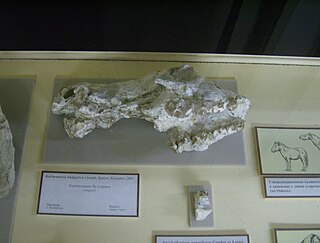
Kalimantsia is an extinct chalicothere from the Miocene of Bulgaria, Europe. It contains one species, Kalimantsia bulgarica.

Anisodon is an extinct genus of chalicothere that lived in Europe during the late Miocene. It stood at about 150 cm (59 in) and weighed around 600 kg (1,300 lb). It is thought that the animal's clawed forelimbs would have allowed it to pull down tree branches in order to browse, as well as deter Miocene predators such as bear-dogs and saber-toothed cats.

Archaeohippus is an extinct three toed member of the family Equidae known from fossils of early Oligocene to middle Miocene age. The genus is noted for several distinct skeletal features. The skull possesses deeply pocketed fossa in a notably long preorbital region. The genus is considered an example of phyletic dwarfism with adults estimated at being on average 20 kilograms in weight. This is in contrast to the most common equid of the period, Miohippus. Characters of the teeth show a mix of both primitive and advanced traits. The advanced traits are very similar to those shown in the genus Parahippus. The noted similarities of Archaeohippus and Parahippus show them to be descended from a common ancestor. They are considered sister species.

Schizotheriines are one of the two subfamilies of the extinct family Chalicotheriidae, a group of herbivorous odd-toed ungulate (perissodactyl) mammals that lived from the Eocene to the Pleistocene. The other clade is the Chalicotheriinae. Both clades had claws rather than hooves on their front feet, an adaptation understood as related to feeding. Schizotheriines also had claws on their hind feet. The fossils of both groups are found in environments that had trees and shrubs. While chalicotheriines developed very derived body forms, schizotheriines remained basically similar in shape to other perissodactyls such as horses and tapirs. Like most forest-dwelling ungulates, they had long necks and forelimbs longer than their hindlimbs. Schizotheriines had longer, higher-crowned cheek teeth than chalicotheriines, which indicates they typically fed on tougher vegetation. The sediments where their fossils are found show they also lived in a wider range of environments, from moist forests to drier woodland or savannah-like environments with trees. Perhaps for this reason, they became more widely distributed than chalicotheriines. Though chalicotheres likely evolved in Asia, schizotheriine fossils are also found in Africa and North America, which they reached by the Bering land bridge. The best-known schizotheriine genus is Moropus. The last survivor of the group was traditionally thought to be Nestoritherium, but it was found to actually be a member of Chalicotheriinae.

Chalicotheriines are one of the two subfamilies of the extinct family Chalicotheriidae, a group of herbivorous, odd-toed ungulate (perissodactyl) mammals that lived from the Eocene to the Pleistocene. The other subfamily is the Schizotheriinae. Chalcotheriines evolved unique characteristics for ungulates, with very long forelimbs, short hindlimbs, and a relatively gorilla-like physique, including knuckle-walking on their flexible forelimbs, which bore long curved claws. Members of this subfamily possessed some of the longest forelimbs and shortest hindlimbs in relation to each other out of all extinct animals. Analysis of dental wear implies that most chalicotheriines fed on seeds and fruit. Their claws were likely used in a hook-like manner to pull down branches, suggesting they lived as bipedal browsers.
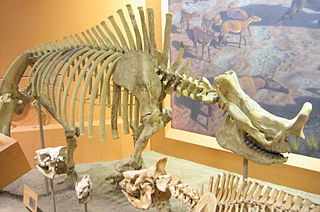
Brontotheriidae is a family of extinct mammals belonging to the order Perissodactyla, the order that includes horses, rhinoceroses, and tapirs. Superficially, they looked rather like rhinos with some developing bony nose horns, and were some of the earliest mammals to have evolved large body sizes of several tonnes. They lived around 56–34 million years ago, until the very close of the Eocene. Brontotheres had a Holarctic distribution, with the exception of Western Europe: they occupied North America, Asia, and Eastern Europe. They were the first fossilized mammals to be discovered west of the Mississippi, and were first discovered in South Dakota.
The Astoria Formation is a geologic formation in Washington state & Oregon. It preserves fossils dating back to the early to middle Miocene.

This timeline of pachycephalosaur research is a chronological listing of events in the history of paleontology focused on the pachycephalosaurs, a group of dome-skulled herbivorous marginocephalian dinosaurs. One of the first major events related to the history of pachycephalosaur research actually regards the discovery of an unrelated dinosaur called Troodon, reported from the western United States by Joseph Leidy in 1856. The type specimen of Troodon was simply an unusual tooth, but the close resemblance between Troodon teeth and pachycephalosaur teeth would cause taxonomic confusion for over a century. This was resolved by Phil Currie in 1987, who realized that Troodon belonged to a group of bird-like carnivores then known as saurornithoidids, but since renamed Troodontidae after Troodon itself. The first scientifically documented true pachycephalosaur remains were discovered in Early Cretaceous rocks from England and named Stenopelix not long after Troodon was named in America. Other notable early finds include the well-known pachycephalosaur Stegoceras validum.

























